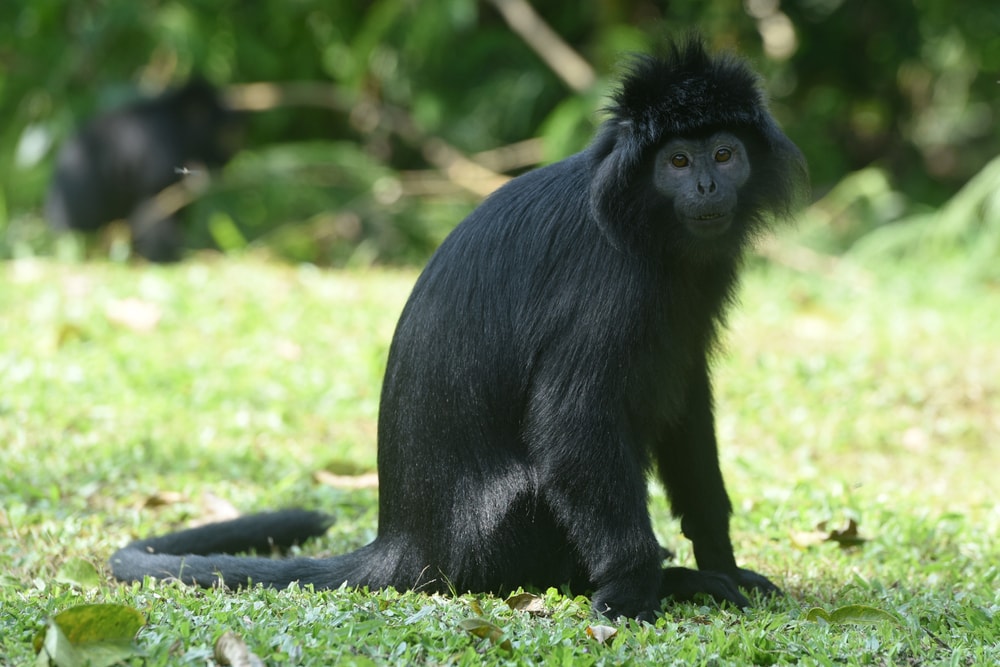Outforia Quicktake: Key Takeaways
- The East Javan Langur is an Old World monkey native to Java, Indonesia.
- Adults have a brownish tinge on their legs, sides, and “sideburns,” and females have a pale yellowish-white patch around their genitals. Juveniles start with orange fur that changes as they mature.
- Adapted to arboreal lifestyles, langurs are skilled climbers with long limbs and tails.
- Langurs inhabit various forest types, including rainforests, lowland forests, mountain forests, and mangroves.
- Their diet consists of leaves, fruit, flowers, and insect larvae. Their specialized stomach structure aids efficient digestion, maximizing nutrient and energy extraction from their plant-based diet.
- Threats to the East Javan Langur include habitat destruction due to deforestation, agricultural expansion, and human settlements, as well as illegal capture and trade for the pet market.
The East Javan langur (Trachypithecus auratus), also known as the Javan lutung, is an Old World monkey native to the island of Java in Indonesia.
Belonging to the Cercopithecidae family, these primates have some unique features that set them apart from other species. But as remarkable as these primates are, they, unfortunately, face several threats.
So, what is it that makes these small primates so special?
Physical Characteristics of the East Javan Langur
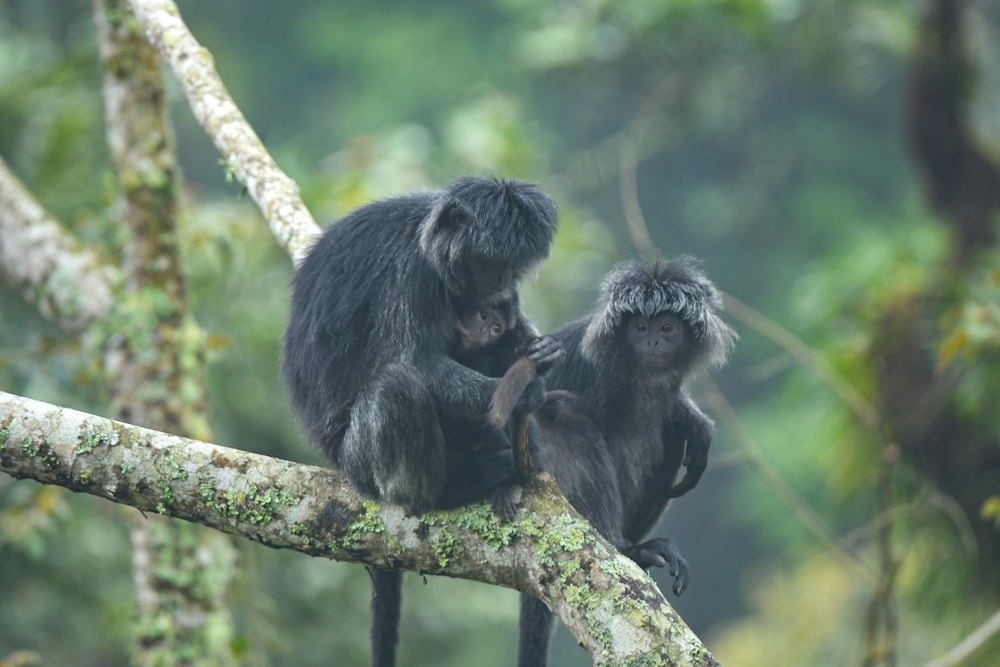
They have a body length ranging from 1-2 ft (30-60 cm). Their fur color varies from light brown to black and gray, depending on their age and environment.
Adult males and adult females are usually glossy black with a brownish tinge to their legs, sides, and “sideburns.” These color variants make them visually distinguishable.
Interestingly, juveniles of both subspecies start off with an orange fur color that eventually changes as they mature.
Females also have a pale yellowish-white patch around their genitals, which is another distinct characteristic of the species.
Notable Adaptations
As an arboreal species, they are well-adapted to thrive in the treetops of rainforests. Their long limbs and tail make them skilled climbers and leapers, which are crucial survival skills in their lifestyle.
Their enlarged salivary glands play a major role in their diet, aiding in the digestion of their primarily herbivorous meals.
These salivary glands provide the necessary enzymes to break down the fibrous plant material they consume.
In addition, the langur’s fur is shorter near their head and gives way to a large crest or mohawk on their back. This feature may serve to protect their heads while navigating the dense foliage and branches of the forest canopy.
You May Also Like: Toxic Amphibians — All About Poisonous Frogs In Florida
Geographic Distribution and Habitat
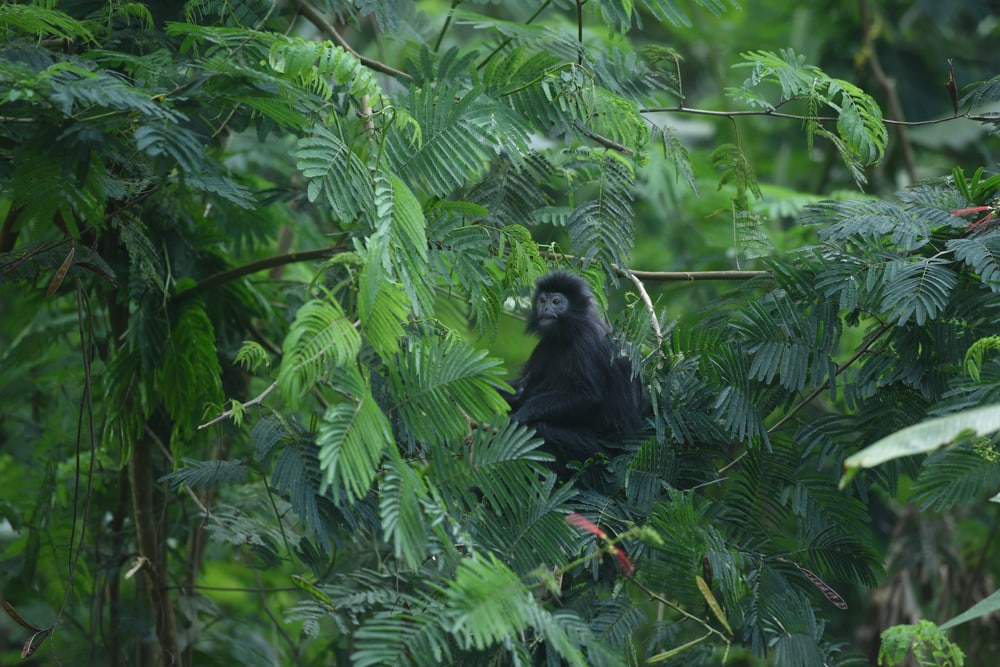
The East Javan langur can be found predominantly in Indonesia. Specifically, they’re found on the island of Java and some of its surrounding Indonesian islands. These primates are native to Southeast Asia, a region known for its rich biodiversity.
As you explore the region further, you might also encounter these langurs on the popular island of Bali.
While their geographic range is limited within Asia, these monkeys remain an essential aspect of the diverse ecosystems in which they inhabit.
Habitat and Home Range
These langurs inhabit various types of forests, including:
- Rainforests
- Lowland forests
- Mountain forests
- Mangroves
These habitats provide them with shelter, food sources, and protection from predators.
At different elevations, these langurs adapt to their surroundings. They can be found in habitats ranging from 837 to 4,114 ft (255-1,254 m) above sea level.
In lowland forests, they seek refuge within the dense vegetation, while in mountain forests, they dwell in areas with cooler temperatures and abundant mosses.
Their habitat preferences also extend to areas of transition. They can be seen moving between different types of forests, such as:
- Natural forests
- Mixed-gardens
- Homogenous timber plantations

Share This Image On Your Site
<a href="https://outforia.com/east-javan-langur/"><img style="width:100%;" src="https://outforia.com/wp-content/uploads/2023/10/east-javan-langur-infographics.jpg"></a><br>East javan langur Infographic by <a href="https://outforia.com">Outforia</a>Lifestyle and Behavior
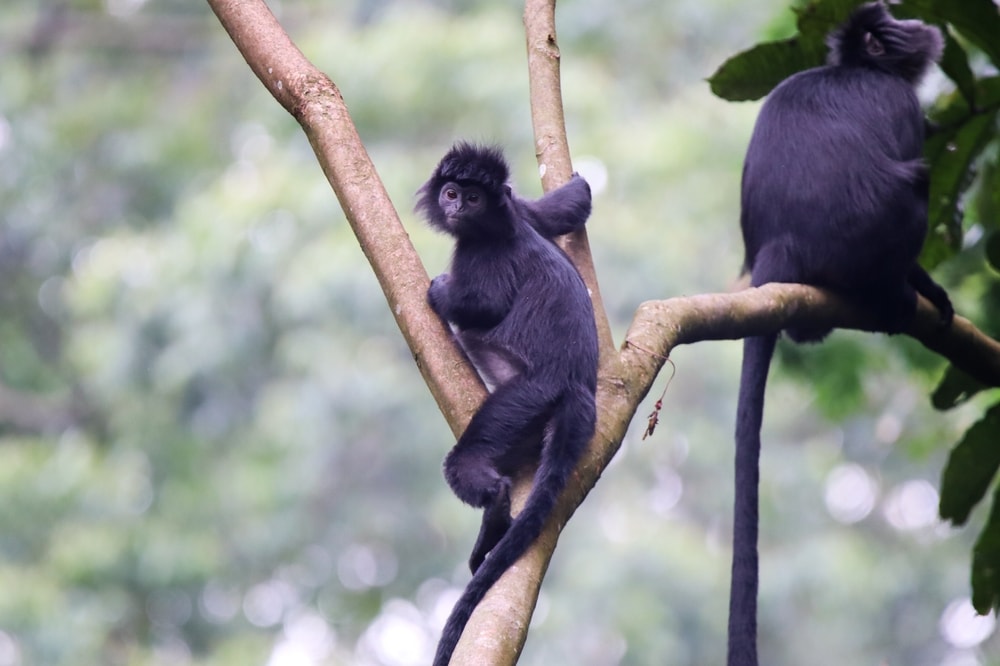
They are diurnal creatures, meaning these langurs are active during daylight hours. They spend most of their time in the trees, using their long tails to help with balance and navigation through the forest canopy.
Being social animals, East Javan langurs typically live in groups. These groups have a hierarchical structure, with a dominant male typically in charge.
The langur’s social behavior also helps provide protection from predators and collectively ensure the well-being of the young.
Communication and Perception
This species communicates with one another through vocalizations and body language. When feeling threatened or aggressive, they may use raised hackles and arched eyebrows to convey the message to others in the group.
In addition, they are highly observant creatures with keen eyesight and hearing capabilities. This enables them to detect potential threats and respond accordingly.
As social animals, communication plays a vital role in maintaining group cohesion, expressing warnings, and engaging in reproductive mating rituals.
You May Also Like: 10 Types Of Habitats Around The World That Animals & Plants Call Home
Dietary Habits
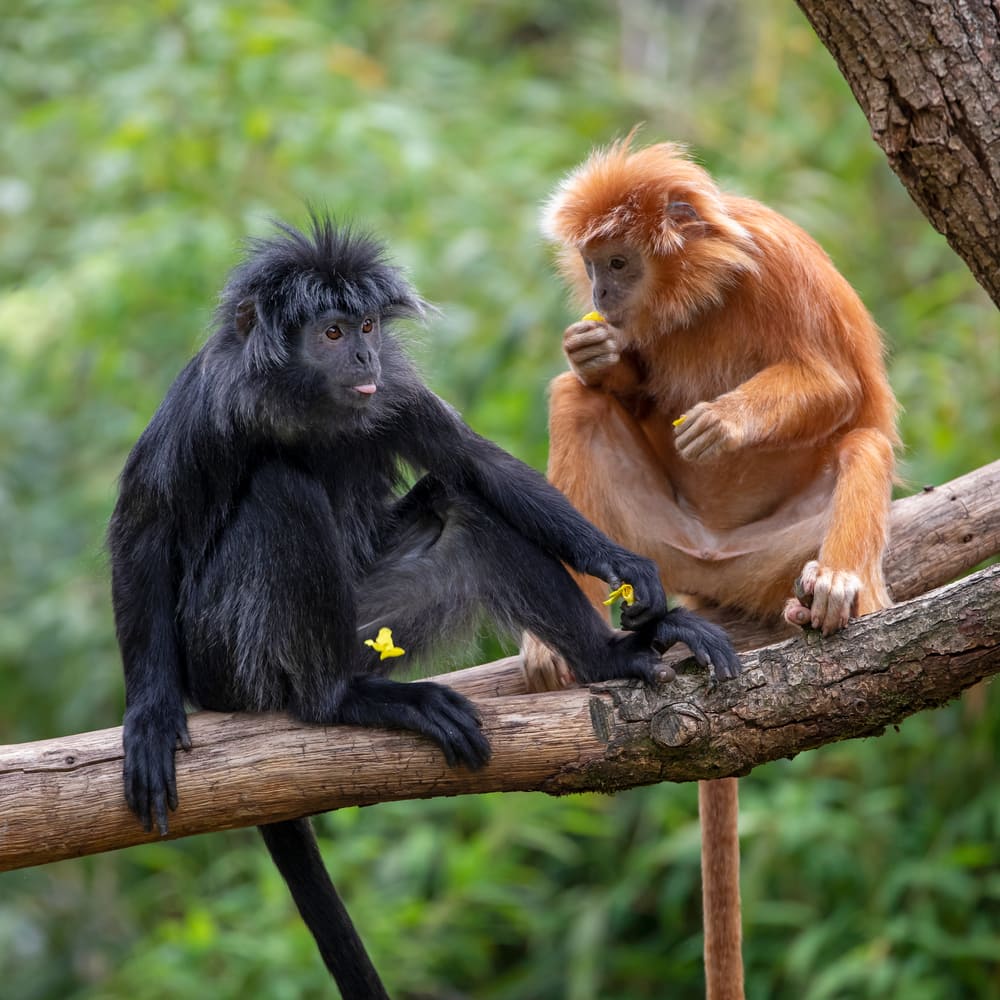
Their diet is primarily herbivorous, which means they consume plant-based food. Their menu consists of a variety of items, including leaves, fruit, flowers, and even insect larvae on occasion.
As a part of their foraging behavior, these animals focus on food that is easily available in their habitat. This includes juicy fruits in the wet season or tender leaves during other times.
While consuming food, the East Javan langur benefits from their specialized stomach structure, which helps digest plant material more efficiently.
This adaptation allows them to extract the maximum nutrients and energy from their plant-based diet.
The Importance of Diet in Their Lifestyle
It mainly relies on its diet to provide vital nutrients and energy required for survival. As they live in groups of about seven individuals, it is essential for them to maintain a healthy lifestyle and share resources amongst group members.
Thanks to their evolved digestive system and feeding habits, these langurs can make the most of the food sources in their environment.
Their food choices are closely tied to their habitat and the availability of food sources. They make the best of their resources by regulating their consumption patterns and choices accordingly.
Reproductive Cycle and Lifespan
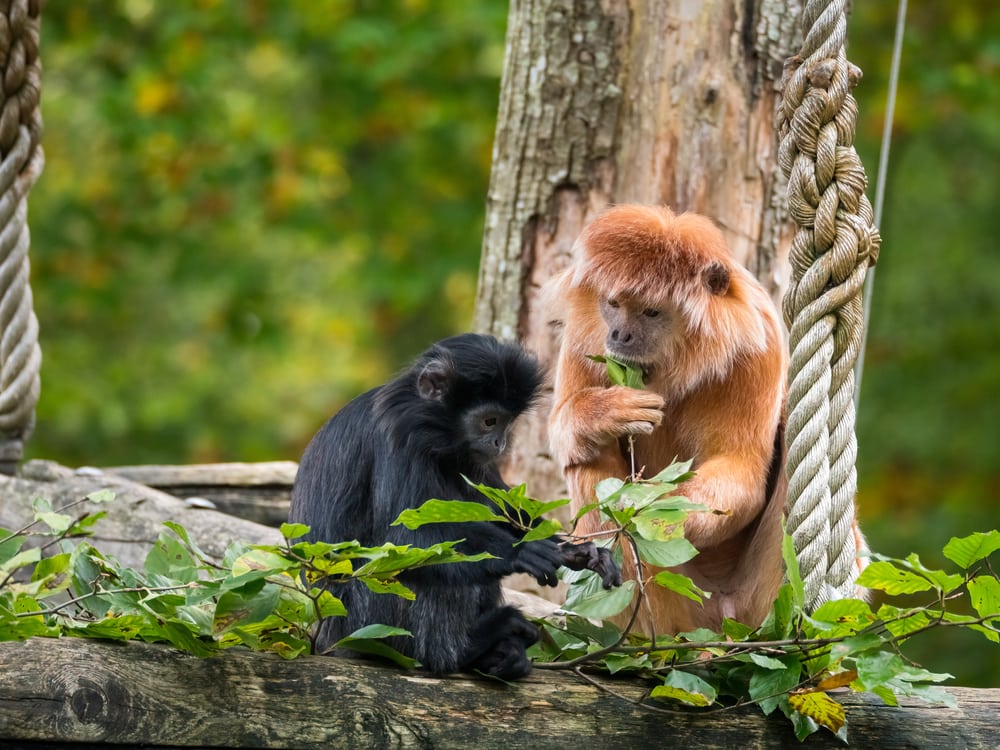
Generally, the reproduction process in these species involves a mating season.
In the case of the East Javan langur, the reproductive cycle of the females has been estimated to be 24 days long. It includes a hormonal pattern consisting of a follicular phase and ovulation.
The mating season provides opportunities for males to showcase their dominance. It also allows them to display their ability to provide for and produce offspring.
Displaying their canine teeth and fighting for dominance within the troop are common ways for males to compete for female attention.
Lifespan and Longevity
In general, langurs have an average lifespan of about 20 years. This could be attributed to their strong social bonds, which provide support and protection throughout their lives.
After a gestation period of about 6 to 7 months, females usually give birth to one offspring. These juveniles are cared for and nurtured by both parents and other members of the troop.
Role and Impact in the Ecosystem

These langurs are predominantly leaf eaters. By consuming large quantities of leaves, they contribute to maintaining a balance within the plant populations in their environment.
Moreover, these adaptable primates serve as both predators and prey within the ecosystem. As prey, their presence provides a valuable food source for their natural predators, such as the critically endangered Javan leopard.
In turn, this relationship helps control the overall population size of East Javan langurs and supports biodiversity in the region.
Economic Importance for Humans
The species’ presence in their native habitat holds both positive and negative implications for humans.
On the one hand, these langurs play a crucial role in seed dispersal and forest rejuvenation, which contributes to the overall health of the tropical rainforests they inhabit.
Healthy forests provide significant benefits, such as water filtration and fresh air, and are critical for the livelihoods of many local communities.
On the other hand, as the human population expands, the inevitable conflict and competition for resources become more apparent.
Often, this results in pressures such as habitat destruction and hunting. Hunting langurs, for example, can negatively impact their populations and disrupt the fragile balance within the ecosystem.
This can potentially cause long-term consequences for both the biodiversity of the region and the ecosystem services that communities rely on.
Threats and Conservation Status
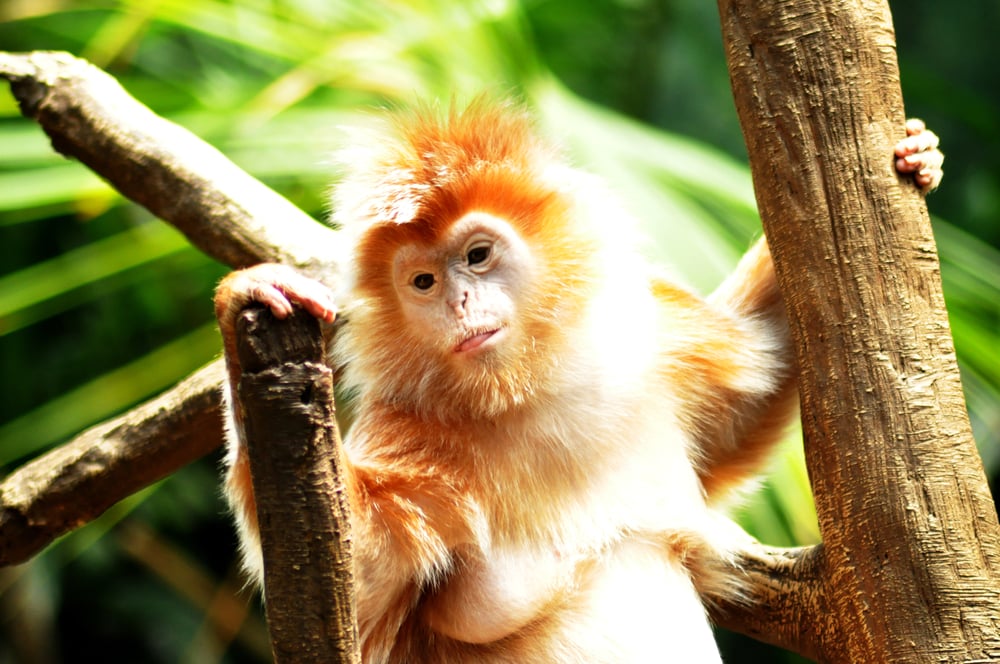
Like many other langur species, this langur faces numerous threats to its survival.
As you may know, habitat destruction is a significant concern. This encroachment on their natural habitat reduces their home ranges, making it difficult for them to find food, mate, and evade predators.
In addition to habitat loss, the East Javan langur also falls victim to illegal capture and trade for the pet market.
Sadly, this mostly affects the young, leaving adults without the necessary social structures to thrive. Furthermore, while they may not be a primary target, these langurs can fall victim to poaching for bushmeat.
Conservation Status
Due to these challenges, the IUCN Red List currently classifies the East Javan langur as vulnerable.
Thankfully, conservation efforts to protect the species and its habitat have been put in place. These efforts have helped grow awareness of their plight.
Comparison with Other Langurs
When examining the East Javan langur’s conservation status, it is helpful to compare it to other langur species for a broader perspective.
For instance, the silvered langur (Trachypithecus cristatus), found in parts of India, faces similar threats but maintains a near-threatened status. Similarly, the Dusky leaf monkey (Trachypithecus obscurus) experiences habitat loss and is listed as near threatened.
On the other hand, the purple-faced langur and the Nilgiri langur are both classified as endangered due to rapid habitat destruction and increased human pressures.
The silvery lutung (Trachypithecus germaini) and the Phayre’s langur (Trachypithecus phayrei) face even more significant challenges, with both species listed as endangered.
You May Also Like: All 21 Types Of Spiders: Identification Guide With Pictures + Facts
Scientific Name and Subspecies
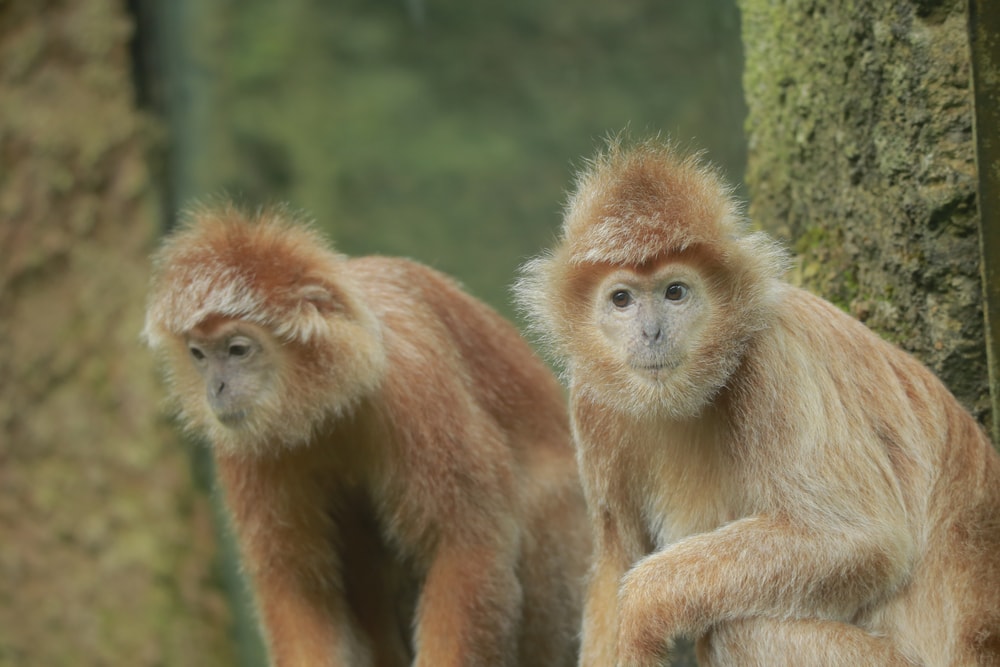
In its scientific name, the Latin word “auratus” means “golden,” referring to this species’ unique coloration. While most East Javan langurs exhibit a glossy black coat, their legs, sides, and “sideburns” often have a brownish tinge.
Their population is divided into two distinct groups, with the East Javan langur retaining the Trachypithecus auratus scientific name. This species was previously known as Trachypithecus auratus auratus.
The other group, the West Javan ebony langur, received its own unique species designation, Trachypithecus mauritius. It was formerly known as Trachypithecus auratus mauritius.
What’s truly captivating, though, is that some members of the East Javan Langur don’t lose their juvenile coloring upon maturing.
Instead, their fur darkens slightly, showcasing yellow tints on the sides, limbs, and around the ears, with a contrasting black tint on the back.
East Javan Langur Frequently Asked Questions
How has human activity affected the East Javan langur?
Human activity, including deforestation, agricultural expansion, and infrastructure development, has led to the destruction of their natural habitat.
This hampers their movement, food availability, and social interactions, further challenging their survival and reproduction.
What conservation efforts are being made to protect the East Javan langur?
Several conservation efforts are in place to protect the East Javan langur. These include habitat restoration, public awareness campaigns, and law enforcement against hunting and illegal trade activities.
Organizations like the U.S. Fish & Wildlife Service work with local partners to strengthen these conservation efforts.
What is the social behavior of East Javan langurs?
East Javan langurs are social animals, living in groups called troops. These groups are usually composed of one adult male, several adult females, and their offspring.
Adult males defend the group’s territory, while females usually take care of the young.



